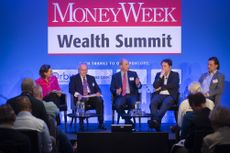Yes, NFTs are a bubble. But like many bubbles of the past, they will change everything
You may think that NFTs (non-fungible tokens) are just another bubble in a world full of bubbles. Well, they are. But that’s actually no bad thing, says Dominic Frisby. Here’s why.


You may think that NFTs (non-fungible tokens) are yet another bubble in a world full of bubbles. How can easily-replicated JPGs that can be screenshotted at a click have a real, long-lasting value?
This is just another pyramid scheme to come out of crypto, which, let’s face it, has a long and checkered history when it comes to dodgy schemes.
Well, you’d be right –and you’d be wrong. Today we talk NFTs; we explain why they are a bubble and we explain how they are going to change the way we think and operate.
Subscribe to MoneyWeek
Subscribe to MoneyWeek today and get your first six magazine issues absolutely FREE

Sign up to Money Morning
Don't miss the latest investment and personal finances news, market analysis, plus money-saving tips with our free twice-daily newsletter
Don't miss the latest investment and personal finances news, market analysis, plus money-saving tips with our free twice-daily newsletter
The “not owning stuff” bubble is bursting
The more venerable readers of this column – anyone over the age of about 45 – might recall the days when content had value. Records, for example. Blokes (mostly) would spend years, decades even, building up a collection of records. As plain a signal of amorous intent as he could ever give would be to record a mix tape of his favourites and hand it to the object of his affections.
And then along came digital technology – iTunes, Spotify and all the rest of it – and the value of that priceless collection went pretty much to zero. The object of affections, now his wife, declared he would have to put that priceless collection in the attic if they wanted the relationship to succeed. Or, better still, give it to a charity shop. And so did the bubble of analogue tech deflate.
Now nobody owns anything. Stuff isn’t an asset, it’s a burden. Generation Rent hires the house, the Rolls-Royce, the holiday home – it doesn’t own it. This asset-light generation prizes experience over material things.
The LP-owning hero of our story makes do with a Spotify subscription, which takes up far less space in his home, which, thanks to an inflated housing market that is verging on the fraudulent, is of a much lower square footage than he would ideally like.
“Most people who own homes are like rich people or old people,” Generation Rent disparages. “We don’t want homes. We don’t want the hassle.” It wants wealth, but is less bothered about physical possessions, so the story goes. They don’t work in the “real world” economy; they work in the digital economy.
In fact, the bubble in “not owning stuff” got so bloated, it had Klaus Schwab of World Economic Forum fame declaring – in what must be one of the most misconstrued statements ever uttered – that by 2030, “You’ll own nothing and you’ll be happy about it.”
Well, surprise surprise, it turns out that people do want to own stuff. In fact, owning stuff – whether it’s caves, or glinting gold nuggets hanging round one’s neck together with shell necklaces, shares in Tesla, or originals of easily-replicated digital art designed by artists with groovy names like Beeple – is about as basic a human urge as there is, surpassed only by eating, reproducing and keeping safe.
What the easy replicability of digital tech did was to devalue content and make ownership much harder. Now NFTs have come along and they are, to misquote Donald Trump, making ownership great again.
What NFTs are really for – owning digital stuff
For sure, NFTs are a bubble –bubbles always accompany new technology. But bubbles also serve a purpose in that they accelerate investment and adoption. Without the railway bubbles, the tracks would not have been laid; nor, without dotcom in 2000, would the cables. Tulips were a bubble and, 400 years on, the Dutch still rule the roost in flowers. Scorn bubbles at your peril.
Remember Frisby’s Law: “A bubble is a bull market in which you don’t have a position.” The first to declare something a bubble are outsiders who have missed out. How many times have the media declared that the bitcoin bubble has burst?
Now the media are declaring the NFT bubble has burst. Figures recently published by nonfungible.com show that the average price of an NFT has “plummeted” (they always use the word “plummeted”, it’s so much more sensational than “gone down”) by 75% from a peak of around $4,000 in February to little more than $1,000 last week.
Well, whatever. It’s a 75% correction. That’s normal in cryptoland. How many 75% corrections have there been in bitcoin? I’ve lost count. $1,000 last week is still ten times higher than the average price of $100 being paid six months ago.
When digital came along, easy and instantaneous replication meant nothing was scarce any more. So content was dramatically devalued. Thanks to blockchain, digital scarcity has now been made possible.
The NFT is essentially a digital token representing ownership. Anyone can view Beeple’s “Everydays — The First 5000 Days”, the artwork recently sold for $69m at a Christie’s auction, but only one person has the ownership token.
That ownership is now verifiable, digitally secured, potentially divisible and easy to transfer. “Everydays” can be copied and pasted – but the token cannot be (that is, assuming the underlying platform is secure, which is another matter).
Most NFTs don’t have any value and the majority of submissions on NFT art markets don’t sell. Most art in the real world has little value too, though some is worth extraordinary amounts. Enough people have to believe in it for it to have any value –Banksy’s work is million-dollar-art to some; graffiti to others.
If an NFT gets a lot of media exposure, its value will increase – just as the stock in a Hollywood star will. If it gets none, it will be the equivalent of the unemployed actor. But the implications of independently-provable digital ownership go way beyond works of art. NFT art is just where the current focus is.
“We are going from a world,” says philosopher Naval Ravikant, “where every protocol has a token, to where every (decentralised) application has a token, to where every valuable digital representation of an object or person has a token. Public blockchains will be the title registries for everything of value. Ultimately, NFTs will authenticate the world.”
We will know who owns what – what is genuine and what isn’t. The implications for content creators are enormous. Online content might even have value again.
Daylight Robbery – How Tax Shaped The Past And Will Change The Future is now out in paperback at Amazon and all good bookstores with the audiobook, read by Dominic, on Audible and elsewhere.
Dominic Frisby (“mercurially witty” – the Spectator) is the world’s only financial writer and comedian. He is MoneyWeek’s main commentator on gold, commodities, currencies and cryptocurrencies. He is the author of the books Bitcoin: the Future of Money? and Life After The State. He also co-wrote the documentary Four Horsemen, and presents the chat show, Stuff That Interests Me.
His show 2016 Let’s Talk About Tax was a huge hit at the Edinburgh Festival and Penguin Random House have since commissioned him to write a book on the subject – Daylight Robbery – the past, present and future of tax will be published later this year. His 2018 Edinburgh Festival show, Dominic Frisby's Financial Gameshow, won rave reviews. Dominic was educated at St Paul's School, Manchester University and the Webber-Douglas Academy Of Dramatic Art.
You can follow him on Twitter @dominicfrisby
-
 Coventry Building Society bids £780m for Co-operative Bank - what could it mean for customers?
Coventry Building Society bids £780m for Co-operative Bank - what could it mean for customers?Coventry Building Society has put in an offer of £780 million to buy Co-operative Bank. When will the potential deal happen and what could it mean for customers?
By Vaishali Varu Published
-
 Review: Three magnificent Beachcomber resorts in Mauritius
Review: Three magnificent Beachcomber resorts in MauritiusMoneyWeek Travel Ruth Emery explores the Indian Ocean island from Beachcomber resorts Shandrani, Trou aux Biches and Paradis
By Ruth Emery Published
-
 Halifax: House price slump continues as prices slide for the sixth consecutive month
Halifax: House price slump continues as prices slide for the sixth consecutive monthUK house prices fell again in September as buyers returned, but the slowdown was not as fast as anticipated, latest Halifax data shows. Where are house prices falling the most?
By Kalpana Fitzpatrick Published
-
 Rents hit a record high - but is the opportunity for buy-to-let investors still strong?
Rents hit a record high - but is the opportunity for buy-to-let investors still strong?UK rent prices have hit a record high with the average hitting over £1,200 a month says Rightmove. Are there still opportunities in buy-to-let?
By Marc Shoffman Published
-
 Pension savers turn to gold investments
Pension savers turn to gold investmentsInvestors are racing to buy gold to protect their pensions from a stock market correction and high inflation, experts say
By Ruth Emery Published
-
 Where to find the best returns from student accommodation
Where to find the best returns from student accommodationStudent accommodation can be a lucrative investment if you know where to look.
By Marc Shoffman Published
-
 Best investing apps
Best investing appsWe round up the best investing apps. Looking for an easy-to-use app to help you start investing, keep track of your portfolio or make trades on the go?
By Ruth Emery Last updated
-
 The world’s best bargain stocks
The world’s best bargain stocksSearching for bargain stocks with Alec Cutler of the Orbis Global Balanced Fund, who tells Andrew Van Sickle which sectors are being overlooked.
By Andrew Van Sickle Published
-
 Revealed: the cheapest cities to own a home in Britain
Revealed: the cheapest cities to own a home in BritainNew research reveals the cheapest cities to own a home, taking account of mortgage payments, utility bills and council tax
By Ruth Emery Published
-
 UK recession: How to protect your portfolio
UK recession: How to protect your portfolioAs the UK recession is confirmed, we look at ways to protect your wealth.
By Henry Sandercock Last updated